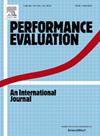Energy-performance tradeoffs in server farms with batch services and setup times
IF 0.8
4区 计算机科学
Q4 COMPUTER SCIENCE, HARDWARE & ARCHITECTURE
引用次数: 0
Abstract
Data centers consume a large amount of energy, much of which is wasted due to idle servers. Turning off idle servers might be an effective power-saving solution; however, there is a trade-off between energy savings and system performance. Hence, we propose a setup queueing model with a batching policy that allows servers to process a set of jobs simultaneously to minimize power consumption while maintaining acceptable performance. We consider an M/M/SET–BATCH queue, a multi-server batch service queue with a fixed batch size and setup times, and some variants, including systems in which idle servers delay before turning off or systems in which the batch size is dynamic. We analyze the steady-state probabilities and system performance of the M/M/SET–BATCH system and its variants. Our analysis of the M/M/SET–BATCH system with lower computational complexity is made possible by utilizing the special structure of the model. In addition, we use simulations to compare the M/M/SET–BATCH model with some other variants with different setup time distributions. The results suggest that the model performs better when the setup time has a larger coefficient of variation. Our results indicate that the batching policy enhances the system performance, especially when we allow servers to be idle before turning them off.
具有批处理服务和设置时间的服务器群中的能源性能权衡
数据中心消耗大量的能源,其中很大一部分是由于服务器闲置而浪费的。关闭空闲服务器可能是一种有效的节能解决方案;然而,在节能和系统性能之间存在权衡。因此,我们提出了一个带有批处理策略的设置队列模型,该模型允许服务器同时处理一组作业,以最小化功耗,同时保持可接受的性能。我们考虑M/M/c/ SET-BATCH队列,一个具有固定批处理大小和设置时间的多服务器批处理服务队列,以及一些变体,包括空闲服务器在关闭之前延迟的系统或批处理大小是动态的系统。我们分析了M/M/c/ SET-BATCH系统及其变体的稳态概率和系统性能。利用模型的特殊结构,我们可以对计算复杂度较低的M/M/c/ SET-BATCH系统进行分析。此外,我们使用模拟来比较M/M/c/ SET-BATCH模型与其他一些具有不同设置时间分布的变体。结果表明,当设置时间的变异系数较大时,模型的性能较好。我们的结果表明,批处理策略提高了系统性能,特别是当我们允许服务器在关闭它们之前处于空闲状态时。
本文章由计算机程序翻译,如有差异,请以英文原文为准。
求助全文
约1分钟内获得全文
求助全文
来源期刊

Performance Evaluation
工程技术-计算机:理论方法
CiteScore
3.10
自引率
0.00%
发文量
20
审稿时长
24 days
期刊介绍:
Performance Evaluation functions as a leading journal in the area of modeling, measurement, and evaluation of performance aspects of computing and communication systems. As such, it aims to present a balanced and complete view of the entire Performance Evaluation profession. Hence, the journal is interested in papers that focus on one or more of the following dimensions:
-Define new performance evaluation tools, including measurement and monitoring tools as well as modeling and analytic techniques
-Provide new insights into the performance of computing and communication systems
-Introduce new application areas where performance evaluation tools can play an important role and creative new uses for performance evaluation tools.
More specifically, common application areas of interest include the performance of:
-Resource allocation and control methods and algorithms (e.g. routing and flow control in networks, bandwidth allocation, processor scheduling, memory management)
-System architecture, design and implementation
-Cognitive radio
-VANETs
-Social networks and media
-Energy efficient ICT
-Energy harvesting
-Data centers
-Data centric networks
-System reliability
-System tuning and capacity planning
-Wireless and sensor networks
-Autonomic and self-organizing systems
-Embedded systems
-Network science
 求助内容:
求助内容: 应助结果提醒方式:
应助结果提醒方式:


